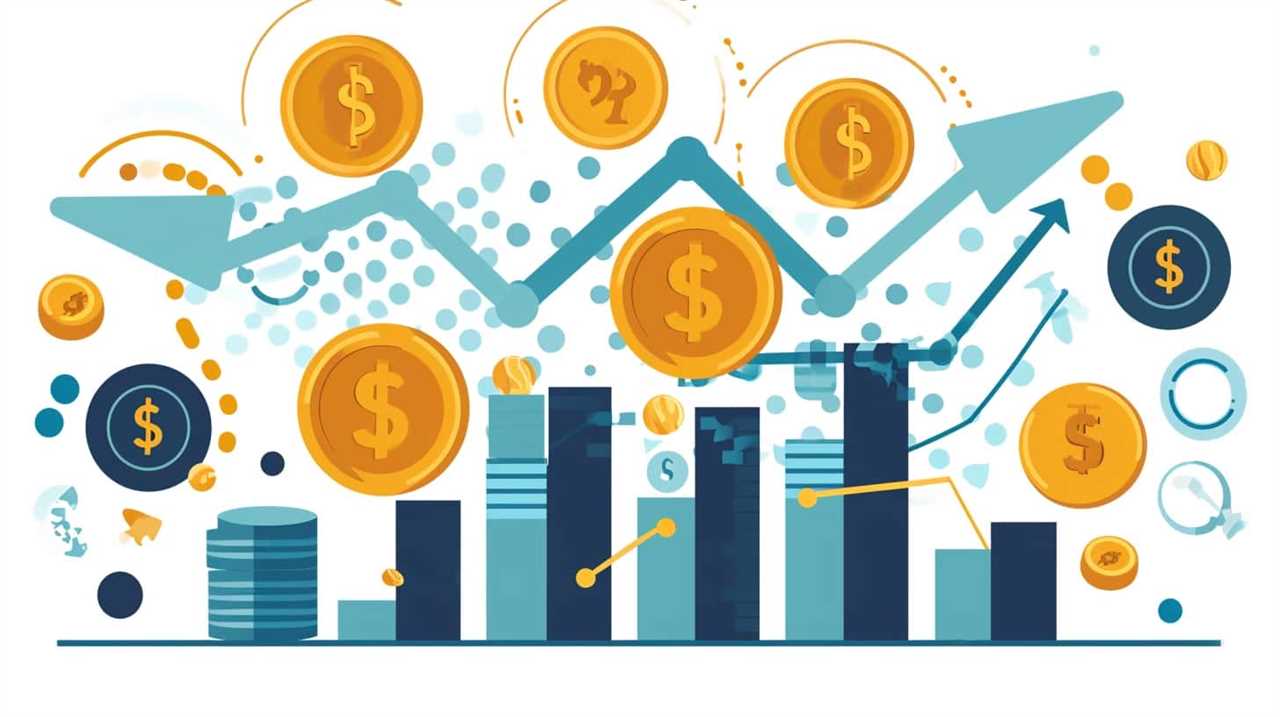What Have Philosophers Said About Market Equilibrium?
In our exploration of market equilibrium, we delve into the wisdom imparted by philosophers throughout history. Just as a compass guides us through uncharted waters, these philosophers serve as beacons of insight, shedding light on the intricate workings of the market.
From Adam Smith’s invisible hand to the balancing act of supply and demand dynamics, they have unraveled the complexities of market forces. They have shown us that self-interest, like the beating heart of innovation, propels the engine of the market.
As we examine the pricing mechanism and the creation and distribution of wealth, we come face to face with the limits of market equilibrium. Join us on this intellectual journey as we navigate the contemporary debates and perspectives surrounding this captivating topic.

Key Takeaways
- The concept of the Invisible Hand, introduced by Adam Smith, promotes the well-being of society through individuals pursuing their own self-interest in the market.
- Self-interest guides individuals to make rational choices in the market, leading to efficient resource allocation and driving innovation and progress.
- Market equilibrium is achieved when supply and demand forces are in balance, and market forces and prices adjust to restore equilibrium in response to changes.
- Government intervention in market equilibrium can lead to inefficiencies, reduced competition, stifled innovation, and moral hazards. Careful consideration of potential drawbacks is important when intervening in market equilibrium.
Adam Smith’s Invisible Hand
In the article, we’ll explore the concept of Adam Smith’s Invisible Hand and its significance in market equilibrium. Adam Smith, a renowned philosopher and economist, introduced the concept of the Invisible Hand in his seminal work, ‘The Wealth of Nations.’ According to Smith, when individuals pursue their own self-interest in a competitive market, they unintentionally promote the well-being of society as a whole.
The role of competition plays a crucial part in the functioning of the Invisible Hand. In a competitive market, multiple individuals and firms engage in the buying and selling of goods and services. This competition creates a dynamic environment where prices adjust based on supply and demand. As a result, resources are allocated efficiently, and market equilibrium is achieved.
The Invisible Hand operates through the mechanism of self-interest. Smith argued that individuals, driven by their pursuit of profit, make rational choices that maximize their own welfare. However, these choices also lead to the production of goods and services that meet the needs and desires of consumers. In this way, the Invisible Hand coordinates the actions of self-interested individuals and ensures that resources are allocated efficiently.
The concept of the Invisible Hand has significant implications for market efficiency. Smith believed that in a free market, where competition is allowed to flourish, resources are allocated in the most efficient manner. The Invisible Hand, through the mechanism of self-interest, guides the economy towards optimal outcomes without the need for central planning or intervention.

The Role of Self-Interest
Self-interest plays a pivotal role in achieving market equilibrium, guiding individuals to make rational choices that maximize their own welfare while also benefiting society as a whole. Incentives, both monetary and non-monetary, play a crucial role in shaping individuals’ self-interest and driving their behavior within the market. Ethical considerations, on the other hand, help ensure that self-interest is aligned with the overall well-being of society.
Here are three key points to consider regarding the role of self-interest in achieving market equilibrium:
- Rational decision-making: Self-interest provides individuals with a strong incentive to carefully consider the costs and benefits of their choices in the market. By seeking to maximize their own welfare, individuals are motivated to make rational decisions that are based on their own preferences and perceived value.
- Allocation of resources: When individuals act in their own self-interest, resources are allocated more efficiently within the market. As individuals pursue their own goals, they engage in voluntary transactions that lead to the allocation of resources in a way that satisfies the preferences and needs of both buyers and sellers.
- Innovation and progress: Self-interest acts as a driving force for innovation and progress within the market. In order to maximize their own welfare, individuals are incentivized to develop new products, improve existing ones, and find more efficient ways to produce and distribute goods and services.
While self-interest is a powerful force in achieving market equilibrium, ethical considerations are essential to ensure that individuals’ pursuit of self-interest doesn’t lead to detrimental outcomes for society. By establishing and enforcing ethical standards, societies can strike a balance between incentivizing self-interest and maintaining a fair and just marketplace.
Market Forces and Equilibrium
Market forces and equilibrium are influenced by various factors that shape the dynamics of supply and demand. When these forces are in balance, market equilibrium is achieved. However, there are instances when the market experiences disequilibrium, causing a temporary disruption in the supply-demand equilibrium. This can lead to market dislocation, where prices and quantities deviate from their equilibrium levels.

Market disequilibrium can occur due to several reasons. Changes in consumer preferences, technological advancements, or government policies can all impact the demand and supply dynamics. For example, a sudden increase in consumer demand for a product may lead to a shortage, causing prices to rise. Conversely, a decrease in demand may result in a surplus, leading to price decreases.
Market dislocation can have significant consequences for businesses and consumers. When prices aren’t in equilibrium, it can create inefficiencies and distortions in the market. This can lead to misallocation of resources and reduce economic welfare.
To mitigate market dislocation, market forces and prices adjust to restore equilibrium. This adjustment process can take time, as market participants respond to changes in supply and demand. Entrepreneurs may seize opportunities to meet unmet demand, while producers may cut back on supply to reduce surpluses. Eventually, the market will reach a new equilibrium, where prices and quantities are in balance once again.
Supply and Demand Dynamics
Price fluctuations and equilibrium are key factors in understanding supply and demand dynamics.

When the demand for a product increases, the equilibrium price tends to rise, signaling to producers that they can charge higher prices.
On the other hand, if there’s a decrease in demand, the equilibrium price tends to fall, prompting producers to lower their prices.
Additionally, shifts in supply can also impact the equilibrium price, as an increase in supply can lead to a decrease in prices, while a decrease in supply can drive prices up.
Understanding these dynamics is crucial for businesses and policymakers in order to make informed decisions and navigate the complexities of the market.

Price Fluctuations and Equilibrium
Through our observations and analyses, we’ve come to understand the intricate interplay between supply and demand that drives price fluctuations and ultimately leads to market equilibrium. Price stability and market efficiency are two crucial aspects of this dynamic process.
In order to fully grasp the concept of price fluctuations and equilibrium, it’s essential to consider the following:
- Demand and Supply: The relationship between demand and supply determines the equilibrium price. When demand exceeds supply, prices tend to rise, and vice versa. Understanding the factors that influence demand and supply can help predict price movements.
- Market Forces: Various market forces, such as technological advancements, changes in consumer preferences, or government policies, can impact supply and demand. These forces play a significant role in driving price fluctuations and reshaping market equilibrium.
- Arbitrage and Speculation: The actions of arbitrageurs and speculators can influence price dynamics. By exploiting price discrepancies, arbitrageurs contribute to market efficiency, while speculators attempt to profit from price fluctuations.
Shifts in Supply
As we delve into the topic of ‘Shifts in Supply (Supply and Demand Dynamics)’, it becomes evident that understanding the factors driving changes in supply is crucial for comprehending market equilibrium. Shifts in supply occur when there is a change in the quantity of a good or service that producers are willing and able to supply at each price level. These shifts can be caused by various factors, known as determinants of supply. Determinants of supply include changes in production costs, technology, input prices, government regulations, and expectations of future prices. By examining these determinants, analysts can gain insights into how supply is likely to change in response to different circumstances. This understanding is vital for predicting market outcomes and making informed decisions in an ever-changing economic landscape.
| Determinants of Supply | Explanation |
|---|---|
| Production Costs | Changes in the costs of production, such as labor, raw materials, and energy, can directly impact the supply of goods and services. |
| Technology | Technological advancements can lead to increased production efficiency and lower costs, resulting in an expansion of supply. |
| Input Prices | Fluctuations in the prices of inputs, such as commodities or intermediate goods, can affect production costs and, consequently, supply. |
| Government Regulations | Changes in regulations, such as taxes, subsidies, or trade policies, can influence the costs and feasibility of production, impacting supply. |
| Expectations | Expectations about future prices can incentivize producers to adjust their current supply levels, anticipating future demand. |
Impact of Demand Changes?
Demand changes have a significant impact on market equilibrium, shaping the interaction between buyers and sellers in the marketplace. Understanding the impact of consumer behavior and market fluctuations is crucial for businesses seeking to stay competitive and innovative.

Here are three key ways in which demand changes can affect market equilibrium:
- Price Fluctuations: When demand increases, prices tend to rise as sellers capitalize on the increased demand. Conversely, when demand decreases, prices may fall as sellers try to attract buyers.
- Supply Adjustments: Changes in demand can lead to adjustments in supply. If demand increases, suppliers may increase production to meet the higher demand. On the other hand, if demand declines, suppliers may reduce production to avoid excess inventory.
- Market Dynamics: Demand changes can also influence the overall dynamics of the market. For example, increased demand may attract new competitors, leading to a more competitive market environment.
Balancing Buyers and Sellers
Balancing the needs of buyers and sellers is crucial for achieving market equilibrium. In the competitive marketplace, the impact of competition and market dynamics play a significant role in maintaining this balance.
Competition among buyers and sellers drives innovation and efficiency. When buyers have multiple sellers to choose from, they’re more likely to find the products or services that best meet their needs. This encourages sellers to continuously improve their offerings, leading to a dynamic marketplace that fosters innovation. Additionally, competition helps regulate prices by preventing any single seller from exerting excessive control over the market.
On the other hand, market dynamics, such as changes in supply and demand, also influence the balance between buyers and sellers. When demand exceeds supply, sellers have the upper hand, leading to price increases. Conversely, when supply exceeds demand, buyers gain leverage, resulting in price reductions. Balancing these fluctuations is vital for achieving market equilibrium.

To achieve this balance, it’s essential to have mechanisms in place that facilitate communication and negotiation between buyers and sellers. This can include platforms that provide transparent information about products, services, and prices, as well as tools that enable buyers and sellers to engage in fair and efficient transactions.
Competition and Market Efficiency
In our exploration of market equilibrium, let’s now delve into the concept of competition and its impact on market efficiency.
Competition dynamics play a crucial role in shaping the efficiency of markets, driving innovation, and benefiting consumers. Here are three key points to consider:
- Enhanced Efficiency: Competition fosters efficiency by incentivizing firms to improve their products and services. In a competitive market, businesses strive to offer better quality goods at lower prices, leading to improved value for consumers. This constant drive for improvement promotes innovation and ensures that resources are allocated efficiently.
- Market Correction: Competition acts as a mechanism to correct market inefficiencies. When a firm enjoys a monopoly position, it can exploit its market power by charging higher prices or providing subpar products. However, competition introduces alternatives and forces monopolistic firms to become more efficient or risk losing market share. This dynamic helps prevent market distortions and promotes fairer outcomes.
- Consumer Benefit: Competition benefits consumers by expanding choices and lowering prices. When multiple firms compete for customers, they’re motivated to differentiate themselves through innovation, quality, and affordability. This leads to a wider range of options for consumers, allowing them to select the best products that meet their preferences and budgets.
Understanding the relationship between competition and market efficiency is crucial for policymakers, businesses, and consumers alike. By fostering competition dynamics, we can drive innovation, correct market inefficiencies, and ensure that consumers benefit from a wide array of choices at competitive prices.

Smith’s Critique of Government Intervention
Smith’s critique of government intervention highlights the potential drawbacks of governmental interference in market equilibrium. Government intervention in markets often aims to correct perceived market inefficiencies and promote fairness. However, Smith argues that such interventions can actually lead to unintended consequences and further distort the natural functioning of markets.
One of the key concerns raised by Smith is the possibility of government intervention leading to market inefficiency. By imposing regulations and controls, governments can disrupt the natural order of markets and hinder the efficient allocation of resources. This can result in reduced competition, stifled innovation, and ultimately, lower overall economic welfare.
Furthermore, Smith emphasizes that government intervention can create moral hazards and encourage rent-seeking behavior. When the government interferes in market outcomes, it can create opportunities for individuals and firms to manipulate the system for their own benefit. This can lead to a misallocation of resources, as resources are diverted towards unproductive activities aimed at securing government favors rather than serving consumer needs.
In light of these concerns, it’s important to carefully consider the potential drawbacks of government intervention in market equilibrium. While there may be cases where intervention is necessary to address market failures, it’s crucial to ensure that such interventions don’t inadvertently exacerbate problems or impede the natural functioning of markets.

The Natural Order of Markets
When considering the natural order of markets, we must first examine the concept of spontaneous market order. This idea suggests that markets have an inherent ability to self-organize and allocate resources efficiently without the need for external intervention.
Furthermore, the invisible hand concept, popularized by Adam Smith, asserts that individual self-interest can lead to the overall benefit of society. These notions highlight the belief in self-regulating market forces that guide economies towards equilibrium.
However, it’s essential to critically analyze the extent to which these ideas hold true in practice and the potential consequences of relying solely on market mechanisms.
Spontaneous Market Order
As we delve into the topic of spontaneous market order, it becomes evident that philosophers have contemplated the natural order of markets. Spontaneous order refers to the idea that markets can self-organize and regulate themselves without the need for external intervention. This concept of market harmony has been a subject of interest for many philosophers throughout history.

- Adam Smith, the father of modern economics, argued that the pursuit of self-interest in a free market leads to beneficial outcomes for society as a whole.
- Friedrich Hayek emphasized the importance of decentralized decision-making in markets, highlighting that individuals possess valuable knowledge that can’t be fully captured by central planners.
- Ludwig von Mises believed that market prices serve as signals that coordinate the actions of buyers and sellers, allowing for efficient allocation of resources.
These philosophers recognized the power of spontaneous market order in promoting innovation, efficiency, and prosperity. By understanding and harnessing this natural order, we can create a more dynamic and innovative economy.
Invisible Hand Concept
Throughout history, philosophers have recognized the power of the invisible hand concept, the natural order of markets, in guiding economic outcomes.
The invisible hand concept, famously coined by Adam Smith, suggests that individuals pursuing their own self-interest in a competitive market will inadvertently promote the best interests of society as a whole. This concept highlights the role of competition in driving market efficiency.
When individuals compete for resources and profits, they’re incentivized to innovate, improve efficiency, and deliver better products and services to consumers. This process of competition creates a dynamic market environment where prices adjust to reflect supply and demand, leading to optimal resource allocation and overall economic welfare.

The invisible hand concept, therefore, emphasizes the importance of market mechanisms in achieving efficient outcomes and promoting innovation in a society.
Self-Regulating Market Forces
One key aspect of market equilibrium is the self-regulating nature of market forces. These forces, driven by the interactions of buyers and sellers, work together to establish a balance between supply and demand. The self-regulating mechanism operates through the pricing mechanism, which adjusts prices to reflect changes in supply and demand. This ensures that resources are allocated efficiently and that market participants respond to changes in market conditions.
The self-regulating nature of market forces allows for flexibility and adaptability in response to external factors, promoting innovation and growth. It also helps to prevent market distortions and maintain stable market conditions. By allowing market forces to operate freely, the pricing mechanism acts as a guiding force, leading to a more efficient allocation of resources and ultimately contributing to the overall health and stability of the market.
This self-regulating mechanism sets the stage for the next concept we’ll explore: spontaneous order and harmony.

Spontaneous Order and Harmony
We frequently observe how markets naturally organize themselves into a state of spontaneous order and harmony. This phenomenon, often attributed to the invisible hand, is a key concept in economic philosophy.
Spontaneous order refers to the way in which individual actions and decisions, driven by self-interest, collectively lead to a structured and efficient market system. It’s through this process that resources are allocated, prices are determined, and supply and demand reach equilibrium.
The idea of market harmony suggests that despite the diverse interests and motivations of market participants, a balance is achieved that benefits society as a whole. This harmony arises from the competition and interaction between buyers and sellers, which drives innovation, efficiency, and the pursuit of profit. As Adam Smith famously wrote, ‘It isn’t from the benevolence of the butcher, the brewer, or the baker that we expect our dinner, but from their regard to their own interest.’
This concept of spontaneous order and market harmony challenges the notion that central planning or government intervention is necessary for economic prosperity. Instead, it argues that the market, left to its own devices, has the inherent capacity to self-regulate and optimize resource allocation. This insight has significant implications for understanding the role of government in the economy and has sparked ongoing debates about the extent to which markets should be regulated.

Transition: While the concept of spontaneous order and market harmony provides insight into the organization of markets, it’s the pricing mechanism that serves as the cornerstone of this process.
The Pricing Mechanism
To understand market equilibrium, it’s important to examine the role of the pricing mechanism. Pricing mechanisms play a crucial role in determining the allocation of resources and goods in a market economy. They facilitate the interaction between buyers and sellers and help establish equilibrium prices that reflect the supply and demand dynamics.
Here are three key aspects of pricing mechanisms:
- Price as a signal: Prices act as signals that convey information about the scarcity or abundance of a particular good or resource. When prices increase, it indicates high demand or limited supply, encouraging producers to increase production or consumers to reduce their demand.
- Price as an incentive: Prices also serve as incentives that influence the behavior of both buyers and sellers. Higher prices can motivate suppliers to produce more, while lower prices may encourage consumers to purchase more.
- Market efficiency: Pricing mechanisms contribute to market efficiency by allowing resources to be allocated in a way that maximizes overall welfare. When prices are determined by the forces of supply and demand, resources flow to their most valued uses, ensuring that goods are produced and consumed at the optimal level.
Understanding the role of pricing mechanisms is essential for analyzing market dynamics and evaluating market efficiency. By examining how prices function as signals and incentives, we can gain insights into how markets allocate resources and promote innovation.

Wealth Creation and Distribution
Continuing the discussion from the previous subtopic, let’s explore how philosophers have addressed the issue of wealth creation and distribution in market equilibrium.
When it comes to wealth distribution, philosophers have long debated the concept of redistribution and its relationship to social justice.
One view is that market equilibrium naturally leads to an unequal distribution of wealth. This perspective argues that individuals with greater abilities and resources are more likely to succeed in the market and accumulate wealth. From this standpoint, any attempts to redistribute wealth would interfere with the natural functioning of the market and undermine individual freedom.
However, proponents of redistribution argue that market outcomes aren’t always fair or just. They contend that wealth accumulation is often influenced by factors such as inheritance, privilege, and unequal access to opportunities. To address these inequalities, they advocate for redistributive policies that aim to level the playing field and promote social justice.

Innovative solutions have been proposed to achieve a more equitable distribution of wealth. These include progressive taxation systems, universal basic income, and wealth caps. These ideas challenge traditional notions of property rights and individual autonomy, but proponents argue that they’re necessary to ensure a just society.
The Limits of Market Equilibrium
When examining the limits of market equilibrium, it becomes evident that there are imperfections inherent in the concept. These imperfections can arise due to various factors, such as information asymmetry, externalities, and market power.
The presence of these external factors can disrupt the ideal state of equilibrium, leading to inefficiencies and suboptimal outcomes in the market. Therefore, it’s crucial to acknowledge and analyze these limits in order to understand the complexities of market dynamics and strive for more effective economic systems.
Imperfections in Market Equilibrium
In the article, we’ll explore the imperfections that arise within market equilibrium, highlighting the limits of this concept.

Market equilibrium, although a fundamental economic principle, isn’t without its flaws. Some of the imperfections and limitations of market equilibrium include:
- Imperfect competition: In reality, markets are often characterized by imperfect competition, where there are a limited number of sellers or buyers, resulting in market power and the ability to influence prices. This can lead to distortions in market equilibrium.
- Market distortions: Various factors such as government intervention, externalities, and information asymmetry can create distortions in market equilibrium. These distortions can result in inefficiencies, unequal distribution of resources, and suboptimal outcomes.
- Dynamic nature of markets: Markets are constantly evolving and subject to changes in technology, consumer preferences, and external shocks. Market equilibrium assumes static conditions, which may not accurately capture the complexities and dynamics of real-world markets.
Understanding these imperfections is crucial for developing innovative solutions to address market inefficiencies and promote economic growth. By acknowledging and analyzing the limits of market equilibrium, we can strive for more robust and inclusive economic systems.
External Factors Influencing Equilibrium
External factors significantly impact market equilibrium and can limit its effectiveness as a predictive model for understanding economic dynamics.
While market equilibrium assumes that all relevant information is reflected in the prices of goods and services, it fails to account for external factors that can disrupt the balance.

These factors include government regulations, technological advancements, natural disasters, and shifts in consumer preferences.
For example, if a new law is implemented, it can alter the supply and demand dynamics, thereby affecting market stability.
Similarly, advancements in technology can lead to the obsolescence of certain products, causing shifts in consumer preferences and disrupting market equilibrium.
Therefore, it’s crucial to recognize and analyze these external factors in order to gain a more comprehensive understanding of economic dynamics and make informed decisions.

Contemporary Debates and Perspectives
As philosophers, we engage in ongoing debates and offer diverse perspectives on the contemporary discourse surrounding market equilibrium. In the field of economics, there are several key contemporary debates and perspectives that shape our understanding of market equilibrium. These debates revolve around the efficiency of markets, the role of government intervention, and the impact of technology on market dynamics.
- Efficiency of markets: One ongoing debate is whether markets are inherently efficient or if there are certain market failures that prevent equilibrium from being reached. Some argue that markets are self-regulating and will naturally reach an optimal equilibrium, while others contend that external factors such as information asymmetry or externalities can disrupt market efficiency.
- Role of government intervention: Another heated debate revolves around the extent to which governments should intervene in markets to ensure equilibrium. Some argue for minimal government intervention, advocating for laissez-faire policies, while others argue that governments should actively regulate markets to correct for market failures and promote social welfare.
- Impact of technology: The rapid advancement of technology has also sparked debates about its impact on market equilibrium. Some argue that technological advancements can disrupt traditional market structures and lead to new forms of equilibrium, while others express concerns about the concentration of power and inequalities that can arise from technological disruptions.
These contemporary debates and perspectives reflect the ongoing quest for a deeper understanding of market equilibrium and its implications for society. By engaging in these debates and offering diverse perspectives, philosophers contribute to the ongoing innovation and evolution of economic theory.
Frequently Asked Questions
How Did Adam Smith’s Concept of the Invisible Hand Influence Modern Economic Theory?
Adam Smith’s concept of the invisible hand greatly influenced modern economic theory. Its influence on capitalism and the role of competition cannot be overstated. It provided a framework for understanding market equilibrium and the self-regulating nature of economies.
What Are Some Criticisms of the Role of Self-Interest in Market Equilibrium?
Critiques of self-interest in market equilibrium raise ethical implications. Examining these concerns allows us to explore the complex relationship between individual motivations and the collective welfare, fostering innovation in economic theory.

How Do Market Forces and Equilibrium Interact With Government Regulations?
Government regulations have a significant impact on the interaction between market forces and equilibrium. They can either distort or enhance market outcomes. Additionally, external shocks play a crucial role in disrupting or stabilizing market equilibrium.
What Factors Can Disrupt the Balance Between Supply and Demand in Market Equilibrium?
Factors such as changes in consumer preferences, economic shocks, and government interventions can disrupt the delicate balance between supply and demand in market equilibrium. These disruptions can lead to price fluctuations and a temporary imbalance in the market.
Are There Any Alternative Economic Systems That Challenge the Concept of Market Equilibrium?
Yes, there are alternative economic systems that challenge the concept of market equilibrium. These systems criticize the assumption that markets naturally reach a state of balance, offering different approaches to distributing resources and addressing inequalities.
Conclusion
In conclusion, the philosophers’ perspectives on market equilibrium reveal the intricate interplay between self-interest, market forces, and the delicate balance of supply and demand.

The pricing mechanism serves as a vital tool for wealth creation and distribution.
However, it’s important to recognize the limits of market equilibrium and engage in contemporary debates to ensure a fair and just society.
Philosophical insights continue to shape our understanding of the complexities of market dynamics and promote critical analysis for a prosperous future.
Lauren’s talent in writing is matched by her passion for storytelling. Her love for books and deep understanding of culture and entertainment add a distinct flavor to her work. As our media and press contact, Lauren skillfully bridges the gap between afterQuotes and the broader media landscape, bringing our message to a wider audience.










